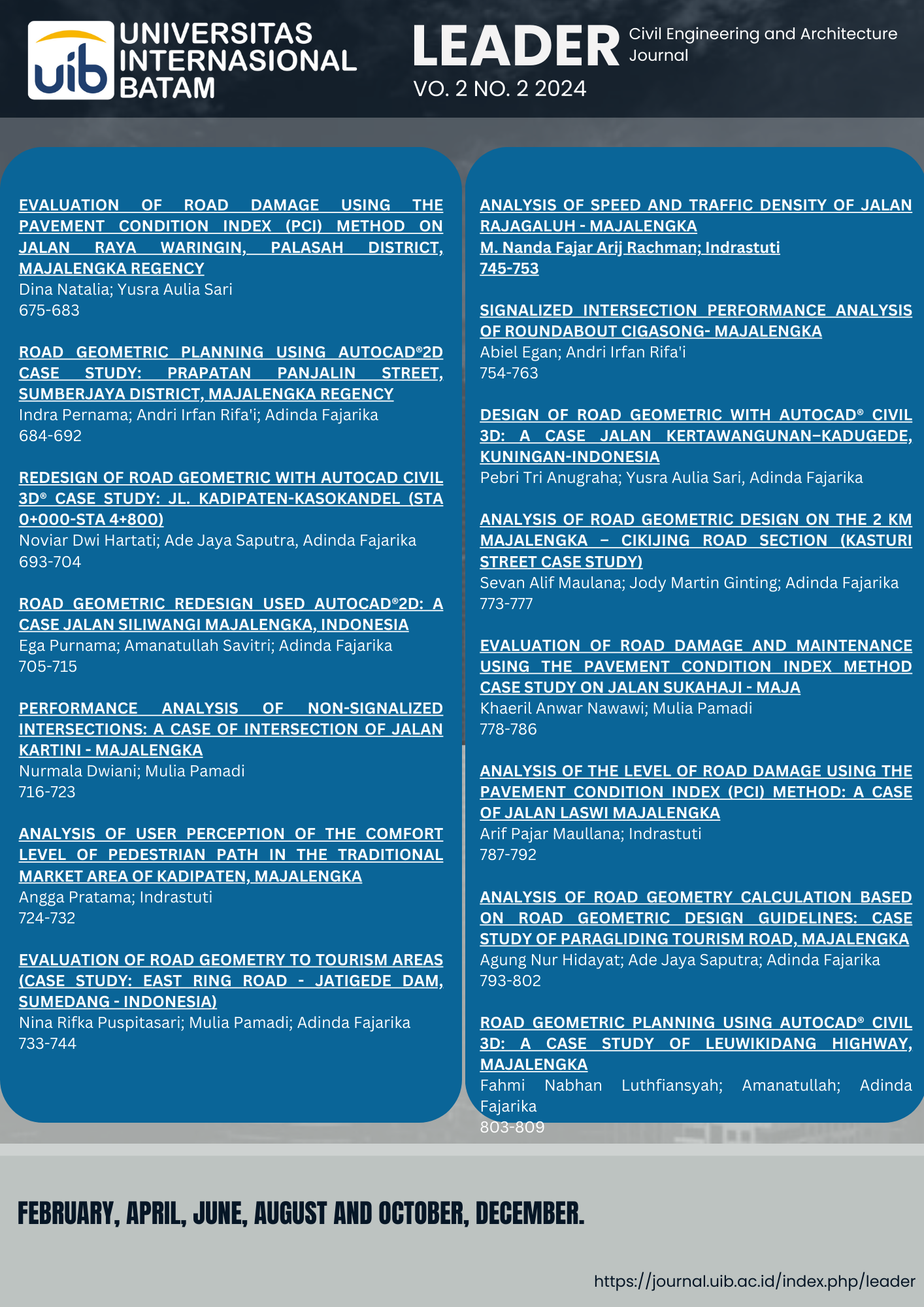PERFORMANCE ANALYSIS OF NON-SIGNALIZED INTERSECTIONS: A CASE OF INTERSECTION OF JALAN KARTINI - MAJALENGKA
DOI:
https://doi.org/10.37253/leader.v2i2.9539Keywords:
Intersections Unsignalized Intersection Congestion AccidentAbstract
As the number of transport increases, the congestion and accidents on the highway increase. Accidents or traffic jams can be caused by an intersection, especially at unsignalized intersections. In Indonesia, accidents and vehicles continue to increase, especially at intersections. Apart from growing accidents, density is also increasing due to increasing or increasing human activity. Research at unsignalized intersections is carried out to prevent increased density and ensure traffic conditions run smoothly. The location of the study to be carried out is at an unsignalized intersection in the Majalengka district. The method used in this research is quantitative, and the data collection technique used is by entering primary and secondary data. Four-way intersection This round has four approaches, each with two paths. The results obtained from calculating traffic volume by conducting direct surveys in the field for three days are divided into two: total flow volume and flow volume of main roads and minor roads. The essential capacity (C0) obtained at a four-way intersection Babakan is 2/2 UD, 2900. Meanwhile, the level of service at the intersection depends on the degree of saturation obtained from the traffic flow value divided by the load capacity. In the previous chapter, the value of the degree of saturation in the north, east, west, and south directions is very high, causing the level of service to be poor. The research results can be used to conclude that the level of service at the four-way intersection Babakan will be more optimal if the load capacity can be increased so that the degree of saturation is low and does not cause high traffic jams.
Downloads
References
C. a. F. Y. a. L. H. X. a. M. W. a. Y. X. Yu, "Integrated optimization of traffic signals and vehicle trajectories at isolated urban intersections," Transportation research part B: methodological, vol. 112, pp. 89--112, 2018.
J. Xu, V. Baliutaviciute, G. Swan and A. Bowers, "Driving with hemianopia X: effects of cross traffic on gaze behaviors and pedestrian responses at intersections," Frontiers in human neuroscience, vol. 16, p. 938140, 2022.
C. Xu, W. Xiao, C. G. Cassandras, Y. Zhang, and L. & Li, "A general framework for decentralized, safe, optimal control of connected and automated vehicles in multi-lane signal-free intersections," IEEE Transactions on Intelligent Transportation Systems, vol. 23, no. 10, pp. 17382-17398, 2022.
C. Tang, J. Sun, Y. Sun, M. Peng and N. & Gan, "A general traffic flow prediction approach based on spatial-temporal graph attention," IEEE Access, vol. 8, pp. 153731-153741, 2020.
A. E. A. O. B. Retallack, "Current understanding of the effects of congestion on traffic accidents," International Journal of Environmental Research and Public Health, vol. 16, no. 18, p. 3400, 2019.
D. S. Pawar, and G. R. & Patil, "Response of major road drivers to aggressive maneuvering of the minor road drivers at unsignalized intersections: A driving simulator study," Transportation research part F: traffic psychology and behavior, vol. 52, pp. 164-175, 2018.
Y. a. A. A. a. F. A. K. a. Z. F. Opeska, "The Influence of the Level of Education, Employment and Legal Culture on the Orderly Compliance of the Traffic Laws of the People of Sungai Penuh City," INTERNATIONAL JOURNAL OF MULTIDISCIPLINARY RESEARCH AND ANALYSIS, vol. 06, no. 05, pp. 1986-1998, 2023.
Q. Ma, S. Zhang, and Q. & Zhou, "Development of a conflict-free unsignalized intersection organization method for multiple connected and autonomous vehicles," Plos one, vol. 16, no. 3, p. e0249170, 2021.
D. a. J. O. Kim, "Cooperative traffic signal control with traffic flow prediction in multi-intersection," Sensors, vol. 20, no. 1, p. 137, 2019.
M. Isradi, Z. Arifin, M. I. Setiawan, R. D. Nasihien, and J. & Prasetijo, "Traffic performance analysis of unsignalized intersection using the Traffic Conflict Parameter technique," Sinergi, vol. 26, no. 3, pp. 397–402, 2022.
H. Fadriani, I. Hidayat, N. R. Adinda, S. Haris, A. G. Mahardika, and B. & Nuryono, "Analysis of Unsignalized Intersection Using PKJI 2014 Method (Study Case: Intersection of Jalan Sukajadi-Jalan Sukawangi-Jalan Sindang Sirna, Bandung," Journal of Physics: Conference Series, vol. 1764, no. 1, p. 012160, 2021.
X. Chen, B. Xu, X. Qin, Y. Bian, M. Hu, and N. & Sun, "Non-signalized intersection network management with connected and automated vehicles," IEEE Access, vol. 8, pp. 122065-122077, 2022.
Q. a. Z. Z. a. Z. Q. a. W. Z. a. L. K. Cao, "Real-time vehicle trajectory prediction for traffic conflict detection at unsignalized intersections," Journal of advanced transportation, vol. 2021, pp. 1--15, 2021.
Cao, Q. A. Zhao, Z. A. Zeng, Q. A. Wang, Z. A. Long, and Kejun, "Real-time vehicle trajectory prediction for traffic conflict detection at unsignalized intersections," Journal of advanced transportation, vol. 2021, pp. 1–15, 2021.
K.-H. N. a. J. J. J. Bui, "Cooperative game-theoretic approach to traffic flow optimization for multiple intersections," Computers & Electrical Engineering, vol. 71, pp. 1012--1024, 2018.
L. Bai, L. Yao, C. Li, X. Wang, and C. & Wang, "Adaptive graph convolutional recurrent network for traffic forecasting," Advances in neural information processing systems, vol. 33, pp. 17804–17815, 2020.
F. a. A. A. a. I. M. a. N. R. A. a. S. M. H. a. K. K.-S. Ali, "Traffic accident detection and condition analysis based on social networking data," Accident Analysis & Prevention, vol. 151, p. 105973, 2021.
S. Ahmad, S. Wasim, S. Irfan, S. Gogoi, A. Srivastava, and Z. & Farheen, "Qualitative v/s. quantitative research-A summarized review," population, vol. 1, no. 2, pp. 2828–2832, 2019.
D. Gharavian, and M. Shahgholian, "Advanced Traffic Management Systems: An Overview and A Development Strategy," arXiv preprint arXiv:1810.02530, 2018.
Q. Wang, J. Wan, and Y. & Yuan, "Locality constraint distance metric learning for traffic congestion detection," Pattern Recognition, vol. 75, pp. 272–281, 2018.
K. J. Silewey, " Research design and methodology," Cyberspace, pp. 1–12, 2019.
Q. Wang, J. Wan, and Y. & Yuan, "Locality constraint distance metric learning for traffic congestion detection," Pattern Recognition, vol. 75, pp. 272–281, 2018.







